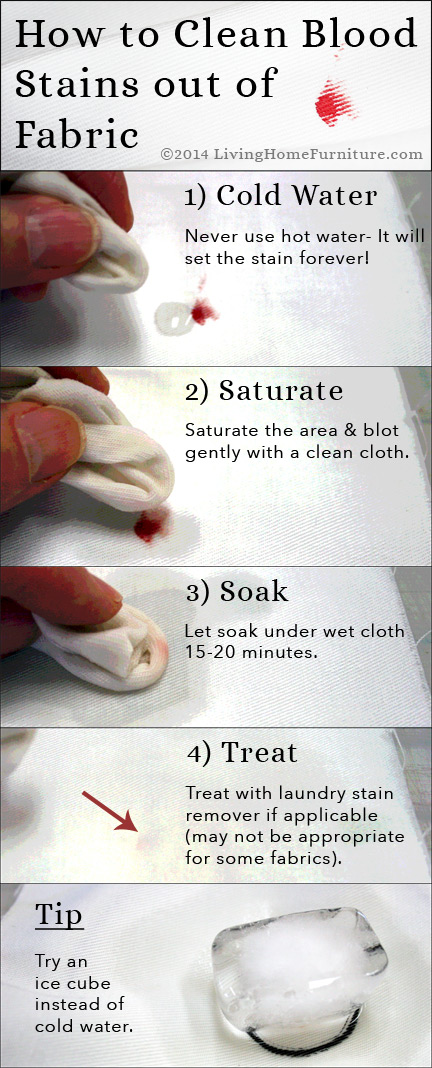To remove dried blood from fabric, start by soaking the stained area in cold water. Then, gently rub the fabric with a mild detergent or soap until the stain lifts.
Dried blood stains can be stubborn and frustrating to deal with. Acting quickly can make a significant difference in successful removal. Blood contains proteins that bond with fabric fibers, making stains tricky. Using the right methods and products is crucial for restoring your fabric.
Whether it’s clothing, linens, or upholstery, knowing how to treat these stains effectively saves time and money. This guide offers simple, effective techniques to tackle dried blood stains without damaging your fabric. Follow these steps to ensure your items look their best again.
Table of Contents
Identifying The Stain
Identifying dried blood stains can be tricky. They often appear dark red or brown. Recognizing these stains early helps in effective cleaning.
Consider the fabric type before treating the stain. Different fabrics react differently to cleaning methods. For example, cotton is easier to clean than silk. Always check the care label for washing instructions.
| Fabric Type | Cleaning Method |
|---|---|
| Cotton | Cold water and mild detergent |
| Silk | Cold water and gentle soap |
| Wool | Cold water and wool detergent |

Credit: casper.com
Pre-treating The Stain
To effectively remove dried blood, start with cold water. Rinse the fabric immediately. This helps loosen the stain. Avoid hot water, as it can set the stain.
Use a clean cloth to blot the area. This will absorb excess blood. Repeat until no more blood transfers to the cloth.
Next, prepare a hydrogen peroxide solution. Mix one part hydrogen peroxide with two parts water. Test on a small, hidden area first. Apply the solution directly to the stain.
Let it sit for about 10 minutes. Blot with a clean cloth until the stain fades. Rinse with cold water to remove the solution.
Choosing The Right Cleaning Method
Choosing the right cleaning method for dried blood stains is essential. Enzyme-based stain removers are very effective. They break down the proteins in blood, making stains easier to remove. Apply the enzyme product directly to the stain and let it sit for a few minutes. Then, rinse with cold water.
Opting for natural remedies is also a good idea. Cold water and soap can work well for fresh stains. Mix a little soap in cold water and gently blot the stain. Avoid hot water, as it can set the stain.
Another option is to use baking soda. Create a paste with baking soda and water, then apply it to the stain. Let it sit for about 30 minutes before rinsing.
Washing The Fabric
Washing fabric with dried blood requires care. Start by selecting the correct water temperature. For fresh stains, use cold water. Cold water helps prevent the stain from setting. For older stains, warm water can work better. Always check the care label for specific instructions.
Choosing the appropriate detergent is crucial. Look for a stain remover or an enzyme-based detergent. These products break down the proteins in blood. Apply the detergent directly to the stain. Let it sit for about 5 to 10 minutes before rinsing. Rinse the fabric under cold water to remove any residue.
Drying The Fabric
Air-drying is a gentle method for removing dried blood from fabric. It helps preserve the fabric’s quality. Lay the fabric flat on a clean surface. Avoid direct sunlight to prevent fading.
Machine drying can be risky. High heat may set the stain permanently. Always check the fabric care label first. Choose a low or medium heat setting if necessary.
Avoiding high heat is crucial. High temperatures can damage the fibers. Instead, use cool air to dry the fabric. This method helps keep the fabric intact and stain-free.
Checking For Residual Stains
Check for any remaining stains after the initial cleaning. Use good lighting to spot them easily. If stains are present, consider a spot treatment.
For lingering stains, use a mix of water and mild detergent. Apply the mixture directly to the stain. Let it sit for 15 minutes before rinsing. Rinse the fabric with cold water to remove the detergent.
Sometimes, repeated washing is necessary. Wash the fabric again if stains persist. Use cold water to avoid setting the stain. Always check the fabric before drying it.
Additional Tips For Stubborn Stains
For tough dried blood stains, an ammonia solution can be very helpful. Mix one tablespoon of ammonia with two cups of cold water. Use a clean cloth to apply the solution to the stain. Blot gently, and do not rub too hard.
Always test the ammonia solution on a small area first. This ensures it will not damage the fabric. Rinse the area with cold water after treating it.
Sometimes, consulting professional cleaners is the best choice. They have special products and tools for tough stains. Professionals can save time and prevent damage to your fabric.
Choose a cleaner with good reviews and experience. Ask about their stain removal methods. This helps ensure your fabric will be treated safely and effectively.

Credit: naturalupholstery.com
Preventing Future Stains
Preventing future stains is easier with some simple steps. Always act quickly on fresh blood stains. Use cold water to rinse the fabric immediately. Blot the stain gently with a clean cloth. Avoid rubbing, as it can spread the stain.
Storing cleaning supplies in an accessible place makes quick action possible. Keep items like hydrogen peroxide and dish soap nearby. A small container for these supplies helps keep them organized. Regularly check and restock items to ensure readiness.

Credit: m.youtube.com
Frequently Asked Questions
What Will Remove Dried Blood From Fabric?
To remove dried blood from fabric, soak it in cold water. Apply hydrogen peroxide or a mixture of baking soda and water. Gently scrub the area and rinse thoroughly. Repeat if necessary until the stain is gone. Always test on a small area first to avoid damage.
Are Dried Blood Stains Permanent?
Dried blood stains can become permanent if not treated promptly. The proteins in blood bond with surfaces, making removal difficult. Regular cleaning methods may not fully eliminate them. Specialized stain removers or professional cleaning may be necessary for effective removal.
Always act quickly for the best results.
Does Hydrogen Peroxide Remove Blood Stains?
Yes, hydrogen peroxide effectively removes blood stains. Apply it directly to the stain, let it bubble for a few minutes, then blot with a clean cloth. Rinse the area with cold water afterward. Always test on an inconspicuous spot first to prevent fabric damage.
Does Baking Soda Remove Blood From Fabric?
Baking soda can help remove blood stains from fabric. Mix it with water to form a paste. Apply the paste to the stain and let it sit for 30 minutes. Rinse with cold water and repeat if necessary for best results.
Always test on a small area first.
Conclusion
Removing dried blood from fabric is achievable with the right techniques. Always act quickly for the best results. Use cold water and gentle cleaning agents for effective stain removal. Remember to test any solution on a small area first. With patience and the right approach, your fabrics can look fresh again.
